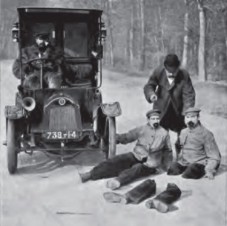Edison studio with battery of lights and electrically-driven camera, from Moving Pictures: How They are Made and Worked
There has been a rush of newly-available e-books on the Internet Archive following expansion of digitisation activity on Google Books, and we’ll be pointing out some of the key titles in coming weeks and placing them in the Bioscope Library. First up is one of the classic early texts on film, a reference work still cited today, F.A. Talbot’s Moving Pictures: How They are Made and Worked.
Frederick A. Talbot was a British writer of popular works on science and engineering subjects, but had a special interest in motion pictures, producing both Moving Pictures (1912) and Practical Cinematography and its Applications (previously written about here) in 1913. Moving Pictures: How They are Made and Worked was originally published in Britain in 1912, in a revised edition in America in Britain in 1914, and a second, completely re-written edition in 1923. The copy in the Internet Archive is the 1914 revision, though it seems to be largely the same as the 1912 original.
Talbot’s task was to explain the phenomenon of the new age. “A vast industry has been established”, he writes, “of which the great majority of picture-palace patrons have no idea, and he moment appears timely to describe the many branches of the art”. Talbot’s focus is on technology and industry, rather than art or entertainment, and his chief interest is in the motion picture as a medium of discovery. But unlike the many dry works from this period which explain the mechanics of motion picture production and exhibition for the benefit of the technician, Talbot’s book bubbles over with enthusiasm. Some of his judgements need to be challenged, but his keen eye and thorough research (including contact with many of the leading figures in the industry) have kept the book fresh and valuable to this day. It is easy to read, and a easy source for good quotations.
He begins by explaining how we are able to see “animated photography”, and it is this section that has probably had the most influence, as Talbot’s somewhat muddled explanation of the “persistence of vision” has been taken as lightly read by many writers. We now know that the persistence of vision is not the reason why we are able to perceive motion (whether motion pictures or any other kind of motion, which is the real matter in hand – see an earlier post on this for an attempt at an explanation). Michael Chanan’s The Dream that Kicks is recommended for its sympathetic analysis of what Talbot got wrong yet how he struggled for the right answer at a time when science (optics etc.) had not properly supplied the information needed.
Talbot find more solid ground when he traces the history of the medium, through experiments in sequence photography of Marey and Muybridge, the discovery of celluloid, the construction of the Edison Kinetoscope and other machines, before moving on to perforations, celluloid manufacture, the taking, developing and printing of films, and their exhibition. He covers the staging of fiction films, though his interest is more in the mechanics than the aesthetics, while his real passion is revealed to be the trick film. Talbot devotes a remarkable six chapters to the trick film, revealing an almost childish enthusiasm for the simple transposition, substitution and distortion effects which characterised early trick films (and which were mostly well out-of-date by the time he wrote the book). The photograph comes from The Automobile Accident (man is driven over by a car, severing his legs, which are then repaired by a passing doctor) which he illustrates and explains in minute detail.
Talbot’s other great enthusiasm is for the motion picture as a medium of education and science. There is some fascinating, well-observed material on microcinematography, electric cinematography and chronophotography, with information (and fine illustrations) gleaned from experimenters such as Percy Smith, Jean Comandon, E.J. Marey and Lucien Bull. Finally, Talbot speculates most interestingly on the possibility of the motion picture as a news medium (“the animated newspaper”, or newsreel, was in its infancy), films in colour (he is an observant Kinemacolor sceptic) and motion pictures in the home.
Though care needs to be taken over some of the evidence and its presentation, Moving Pictures: How They are Made and Worked still stands up as a fine illustration of what possibilities lay before a young medium whose rules had not yet been firmly established. In the 1923 edition Talbot expresses some disappointment that progress in the fields of education and science “has been less spectacular than in that devoted to pure entertainment”. In 1912 motion pictures might yet do anything.
Moving Pictures is available from the Internet Archive in Flip Book (25MB), PDF (6.9MB), full text (702KB) and DjVu (8MB) formats). Note that the PDF link takes you to a Google page which seem only to have sections of the book available – the full PDF version can be found by clicking on the Internet Archive’s “All files: http” link.


An excellent place to start on the question of persistence of vision is Yves Gallifret’s ‘Visual persistence and cinema?’ Comptes Rendus Biologies 2006: 369-385 (the article is in English). Gallifret looks at the science of motion perception in the early twentieth century – it’s technical but interesting. Also, check out George Mather’s paper on two-stroke illusory motion (Vision Research 2006: 2015-2018) and his website at http://www.lifesci.sussex.ac.uk/home/George_Mather/Motion/, which has loads of stuff on how motion perception works.
Nick Redfern
Thanks for the tip, and thanks for the link to George Mather’s website – which is handsomely illustrated with QuickTime movies. As he says, it all starts with our need, as animals, to see things move (either something is hunting us or we’re hunting them).
Stephen Herbert’s paper (on the excellent Grand Illusions site) explains the persistence of vision fallacy (in terms of motion picture perception, that is) very well:
http://www.grand-illusions.com/articles/persistence_of_vision/